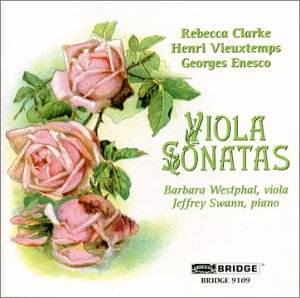It’s interesting to speculate – interesting if fruitless
– on the fortunes for Rebecca Clarke’s Viola Sonata had it been recorded
in the 1920s or 1930s. Columbia embarked on a mini series of composer-authorised
sonata recordings – Albert Sammons and John Ireland in the latter’s
Second Violin Sonata, Lionel Tertis and Arnold Bax in his Viola Sonata,
both of which fell prey to the unfavourable economic climate of the
Wall Street crash and were never issued (though they both survived and
are now in the catalogue, the former on Dutton, the latter on Pearl).
Clarke was a viola player herself and a fine one, and received some
lessons from Tertis (though he doesn’t mention her in his autobiography)
but she made only one recording, for Compton Mackenzie’s National Gramophonic
Society in 1930 – Mozart’s Kegelstadt Trio with clarinettist
Frederick Thurston and pianist Kathleen Long. If Aeolian Vocalion had
been more on the ball they might have given the work an airing between
1920 and 1924 – they had Tertis on their roster of artists at the time
or could have signed the young composer herself. It would certainly
have raised her profile if nothing else. Still, a fruitless diversion
given the relative indifference with which her work was received by
recording companies and promoters at the time.
Her time has come of course, and it’s true not just
of the Viola Sonata which has a number of recordings to its name – Garfield
Jackson and Martin Roscoe on ASV, Dann and Vogt on CBC, Schotten and
Collier on Crystal, Coletti and Howard on Hyperion (for some a front
runner - review)
as well as Riebl and Höfer on Project Arts Nova and more recently
Helen Callus and Robert McDonald, again on ASV – a most well-chosen
disc coupling Clarke (and including Morpheus and Lullaby as well) with
works by Freda Swain, Janetta Gould and Pamela Harrison.
[see also Clarke, Martinu and Regaer Viola Sonatas on Calliope
- LM] Barbara Westphal and Jeffrey Swann’s disc was recorded
and released in 2001 and makes a versatile addition to the catalogue,
coupled as it is with Enescu’s youthful Concert work and Vieuxtemps’
established mid nineteenth century classic. Westphal is excellent in
the folk inflected episodes of the Impetuoso first movement of the Clarke,
bringing off the quasi-improvisatory opening flourish with creditable
panache. She can mine the consolingly reflective second subject as well
– even if the repeated notes here did not sound absolutely vibrant –
and catches the lift as the movement opens out expressively, Jeffrey
Swan offering finely graded dynamics. Westphal and Swann are not as
vigorous in the Vivace second movement as some but they do explore the
implications of the vertiginous decent from highest to lowest strings
fully – and bring a playful patina to the movement. Swann’s rippling
piano work is pleasurable here and Westphal follows the viola’s lyrical,
somewhat discursive line with intelligence and judgement. Westphal maintains
intonation in the highest registers in the difficult finale and she
brings a cultivated simplicity in terms of tone and line. In one of
the work’s most tricky passages – the transitional moment from Adagio
section to Allegro – embodied by the buzzing viola, she emerges well.
As the work draws to an end Westphal and Swann successfully explore
the contrastive interior and exterior material.
Vieuxtemps’ Sonata dates from 1863 and is in three
movements. Westphal and Swann are certainly attuned to its brand of
stately nobility in the opening movement and manage to contrast this
with moments of little declamatory outbursts. The conclusion is effected
with maestoso grandeur, Westphal full of depth and sensitivity. The
second movement is a whimsical little Barcarolle, variational, exploring
registral potential in the viola – both light and dark – and the finale
a bounding, charmingly off-hand creation. In fact the work lightens
as it develops, divesting itself of pomp and embracing charm and lightness.
To conclude we have Enescu’s prentice work – rather pastoral and full
of roulades and double stops, covering some stylistic ground – including
the salon – as well as testing register solidity and vibrance in the
performer. In the faster section of this nine-minute work there’s a
degree of room for expressive elasticity. Enescu apparently said that
he wrote the work as a student and arranged it for viola and orchestra
(a version now lost). It does certainly resemble, as the notes suggest,
a conservatoire test piece in its all-embracing potential for lyrical
and digital freedom.
This is a useful recital that dispenses with the chronological
running order – it starts with the Clarke – and is attractively phrased
and well played. Notes are good and sound quality excellent.
Jonathan Woolf

![]() for
details
for
details